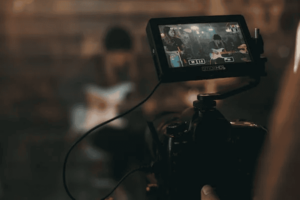An art director, broadly speaking, is someone who manages a team of designers who work on a creative project. Art directors are responsible for the images and visual style of a project and can work in industries such as:
- Film and television
- Magazines
- Newspapers
- Product packaging
All in all, an art director will create the overall design of a project while directing other people to develop artwork and layouts.
What Does an Art Director Do?
Your specific duties as an art director will depend on the industry in which you work. Examples include:
Advertising/public relations
An art director will make sure their clients’ desired image and message are conveyed to consumers. An art director in these industries would be responsible for the overall visual aspects of media and advertising campaigns while coordinating the work of other related staff.
Movie and TV production
The art director will collaborate with a project’s director to decide the sets a filming project needs, and they’ll also decide the look and style those sets should have. The art director will also hire and supervise a staff that includes set designers and/or assistant art directors to complete a project’s designs.
Publishing
An art director usually oversees the page layout of magazines, catalogs, or newspapers, or they choose the cover art for periodicals or books. Work can include internet publications as well, in which case the art director would oversee the creation of a website used for publication.
Art Director Duties
Leading a team of artists, an art director typically fulfills the following duties:
- Determine the types of artistic elements to use on a project, including art and photographs
- Determine the best way to visually represent a concept
- Articulate the vision of a project to their team
- Depending on the industry, develop the overall style or look of:
- Advertising campaigns
- Publications
- Film set
- Television set
- Theater set
- Review and approve work other staff members produce, such as:
- Artwork
- Copy
- Design
- Graphics
- Photography
- Develop budgets
- Develop timelines
- Manage staff and oversee other artists, including:
- Graphic designs
- Exhibit designers
- Set designers
- Coordinate activities with other departments, including creative and artistic departments or producers and directors
- Talk to clients in order to develop artistic approaches and styles
- Present projects to clients for approval
Creative Director vs. Art Director
If you’re thinking of working in one of these roles (and who hasn’t after watching Mad Men?), it’s important to differentiate between the positions. While the job titles creative director and art director can sound very similar — and the roles can overlap in smaller companies and agencies — they are two different roles.
Creative directors are usually the head of a creative team. They have the final say about what goes to a client. This role focuses on managing a team and developing a creative vision. Creative directors will:
- Go to meetings with clients
- Lead brainstorming sessions
- Spearhead a project’s initial concepts
- Make future plans to ensure the process and result match a client’s goals
A creative director will provide the conceptual idea behind a project. Then, it’s up to the art director to execute the details. An art director will be responsible for leading their own teams and creating a project’s aesthetics.
Things to consider when choosing a path include:
- Do you like the idea of creating concepts and selling that idea? Becoming a creative director could be fulfilling.
- Or, do you enjoy hands-on work and making a concept come to life more? Then an art director role could be a better fit.
- Also, consider if you’re more comfortable looking at the big picture or the smaller picture. If you’re a big-picture person, you might prefer creative direction, while little-picture people who like playing around with details tend to gravitate more toward art direction.
What Makes a Good Art Director?
You don’t only need to have creative talent as an art director. In addition to being a creative art director, the role involves working with a lot of different people on projects. You therefore also need the right personality and temperament for this job.
Art Director Qualities and Personality
Successful art directors have some traits in common, including:
- Communication skills
- Creativity
- Leadership skills, including the ability to persuade
- Resourcefulness
- Time-management skills
You can explore the Holland Code framework and take a career test to see if your interests are a good fit.
Art Director Experience and Education
An art director position typically requires at least a bachelor’s degree in a subject related to art or design as well as previous work experience. Art directors may have worked previously in roles such as:
- Copy editor
- Fine artist
- Graphic designer
- Illustrator
- Photographer
Many art directors have a Bachelor of Arts or Bachelor of Fine Arts degree. Aspiring art directors may also complete a Master of Fine Arts (MFA) degree.
Is Art Director a Good Career?
If you’re aspiring to be an art director, you should consider your job prospects, potential earnings, and work environment to decide if this job would be a good fit for you.
Art Director Job Growth, Outlook, and Job Prospects
The employment of art directors is expected to decline due to a decline in traditional publishing, such as books, newspapers, and periodicals. However, art director roles are expected to experience growth when focusing on mobile platforms and websites. Strong competition for these senior roles is to be expected.
Art directors typically report to an associate creative director or creative director. These roles may offer the next step in a career.
Art Director Salary
According to the U.S. Bureau of Labor Statistics, the median annual salary for this job is $94,220. Median salary varies by industry, with median wages as follows:
- Motion picture/video industries: $121,830
- Advertising/public relations: $97,470
- Specialized design services: $93,780
- Publishers (such as newspapers, magazines, and books): $82,270
Art Director Career Expectations and Work Environment
An art director can be self-employed. They may also work for:
- Advertising or public relations firms
- Motion picture and video industries
- Publishers, such as magazines or newspapers
- Specialized design service firms
Even if you’re self-employed, you will need to be able to collaborate with designers and other staff on teams, such as marketing and visual effects.
Typically, art directors work in a fast-paced environment. Art directors must be able to meet strict deadlines and work under pressure.
Art Director Similar Professions
Most art directors will have at least five years of working experience in another related job before they move into this role. Various jobs are similar to the role of art director in different ways:
- Advertising manager
- Artists such as animators or multimedia artists
- Craft and fine artist
- Curator
- Editor
- Fashion designer
- Graphic designer
- Landscape architect
- Industrial designer
- Interior designer
- Photographers
- Public relations specialist
- Roles in film and television like producers and directors
- Writer
Tips for Becoming an Art Director
Keep certain tips in mind if you’re going into this profession:
- Remember, it’s about teamwork.
- Put together an amazing portfolio.
- Don’t focus on the hierarchy.
- Be confident when it comes to feedback.
- Make friends and network.
- Get on-the-job knowledge.
You can also explore these resources:
- Art Directors Club
- Art Directors Guild
- The One Club for Creativity
- These ads with great art direction
- Searching for jobs
If you’re interested in becoming an art director for film or television projects, you can learn more about film and how you can improve your skills by applying to the Nashville Film Institute here.
Videos on Art Director
Film 101: What’s an Art Director?
Exploring The Art Director Career Path: The Tasks, Salary, and Promotion Tips At Every Level
The Impact of Art Direction in Film
A Day in the Life of an Art Director












